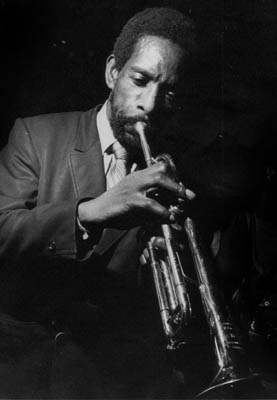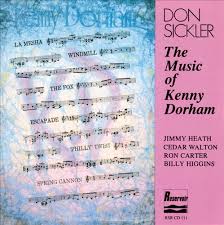Blue Lament – Kenny Dorham
A fascinating ballad with all the trademarks of the Kenny Dorham sound. The first issued recording is on Don Sickler’s 1983 tribute to K.D. Full Score, parts and alternate parts are available for the recorded quintet arrangement.
- Recording: Don Sickler - The Music Of Kenny Dorham
- Recorded on: November 12, 1983
- Label: Uptown (UP27.17)
- Concert Key: No key center
- Vocal Range: , to
- Style: Ballad
- Trumpet - Don Sickler
- Tenor Sax - Jimmy Heath
- Piano - Cedar Walton
- Bass - Ron Carter
- Drums - Billy Higgins
Video
- Description
- Historical Notes
- Solos
- Piano Corner
- Bass Corner
- Drum Corner
- Guitar Corner
- Inside & Beyond
- Minus You
A fascinating song in that inimitable Kenny Dorham style. Blue Lament is full of subtle detail of all kinds—there is always something of interest in the melody, harmony, rhythm and arrangement—without ever being overly complicated. It’s held together by an extremely memorable melody, haunting and solemn throughout. The flow of both melody and changes is so exquisitely natural that it’s easy to overlook that this song actually has no key center. Though F minor, B♭ minor, and D♭ major are all touched on at some point in the form, there are no clear resolutions; the final chord, Dmaj7(♯11), is really more of a stepwise “side-slip” than any sort of tonic.
Like the melody, the form is clever and subtly unpredictable. It’s 24 measures in total, but the second eight measures (the B section) is actually twice as fast, a double-time swing section with a rhythmic riff in the piano and drums filling in the long notes of the melody. C is back to the ballad tempo; it’s eight measures again but not quite a repeat of A. Instead, the start of the A section melody returns starting with a pickup to the second measure of C. The melody goes in a different direction in the last three measures of C, with a dramatic rise and fall.
Solos are on the head form, but with double-time on both the A and B sections (D and E in our lead sheets and parts). The harmonic rhythm of D is the same as A at the ballad tempo, written as 16 measures in double-time. The D.S. for the out melody goes to the second measure of C, resulting in an out melody only seven measures long. There is a four-measure piano intro on the recording, based on the beginning of the melody; this is not shown in our score and parts.
About the arrangement: We have a Full Score and parts for the arrangement as recorded by Don Sickler. Our lead sheet is the 1st horn part. The 2nd horn part adds harmony for some of the A section, and joins the piano and drum hits at B. Our rhythm section parts are fully notated; the piano part shows voicings for most of the melody besides the B section hits.
Like the melody, the form is clever and subtly unpredictable. It’s 24 measures in total, but the second eight measures (the B section) is actually twice as fast, a double-time swing section with a rhythmic riff in the piano and drums filling in the long notes of the melody. C is back to the ballad tempo; it’s eight measures again but not quite a repeat of A. Instead, the start of the A section melody returns starting with a pickup to the second measure of C. The melody goes in a different direction in the last three measures of C, with a dramatic rise and fall.
Solos are on the head form, but with double-time on both the A and B sections (D and E in our lead sheets and parts). The harmonic rhythm of D is the same as A at the ballad tempo, written as 16 measures in double-time. The D.S. for the out melody goes to the second measure of C, resulting in an out melody only seven measures long. There is a four-measure piano intro on the recording, based on the beginning of the melody; this is not shown in our score and parts.
About the arrangement: We have a Full Score and parts for the arrangement as recorded by Don Sickler. Our lead sheet is the 1st horn part. The 2nd horn part adds harmony for some of the A section, and joins the piano and drum hits at B. Our rhythm section parts are fully notated; the piano part shows voicings for most of the melody besides the B section hits.
Kenny Dorham recorded Blue Lament on March 19, 1961, on a sextet session for Blue Note which remains unreleased. Don Sickler’s “The Music Of Kenny Dorham” version is the only recording of this song so far; it certainly deserves to be better known. Like K.D.’s session and the vast majority of Blue Note albums in the ‘50s and ‘60s, Don’s album was recorded at Rudy Van Gelder's Studio.
Related Songs
Email Send Blue Lament to a friend
Send this page to a friend via email. Add your name or email in the first field. In the second, add one or more email addresses, separated by a comma.

Kenny Dorham
August 30, 1924 – December 15, 1972
August 30, 2025, is Kenny Dorham's 101st birthday: jazzleadsheets.com has added many new K.D. compositions. Jazz At Lincoln Center has dedicated three late-night sets to Kenny's music, played with love by young musicians who want his music to live on. Join in, play K.D. music! Read more...
There was a problem.
...

